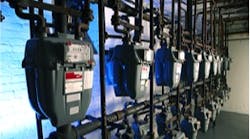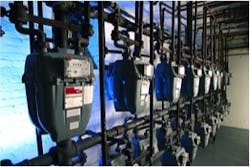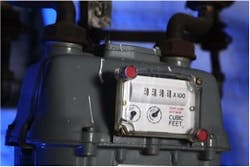Finally, the powers-that-be have come up with a new way to measure energy savings. They’ve figured out that the “wish-a-watt” method of declaring energy savings using assumptions needs an upgrade. Here is what’s coming: the idea that there will be no savings realized until energy reduction shows up at the utility meter. Let’s look at the problems this will cause for when you attempt to sell your services using this new measurement method.
How Savings at the Meter Works
Data is collected from the smart meter documenting the energy consumption of the home or building for a full year before the energy upgrades are done. This is called a baseline. Then you sell and install any energy improvements.
One year later, the utility gathers consumption data from the meter, and subtracts to find the energy savings compared to the year before. This is being labeled a Pay-for-Performance utility program. After that, an incentive is calculated and paid.
Of course, there are many more conditions, both good and bad. The good news is utilities will finally begin paying for real savings. Hopefully, the years of wish-a-watt have come to an end.
Selling the Job – The Real Impossibility
The folks who dreamed up savings at the meter started with a positive idea. After looking at it, you can be sure these people have never been across the table from a real customer in a sales situation. The critical elements that allows a contractor to sell a job, and a customer to buy have been overlooked. The point of sale is where this pay-for-performance falls apart.
Unfortunately, the idea of savings at the meter is only half-baked when it comes to the realities of the market. The decision to purchase energy upgrades is made based on the information conveyed to the customer by the HVAC professional. Customers make their decision to buy based on trust, perceived benefits, the scope of work for the project, and the cost.
As the saying goes, “Nothing happens till somebody buys something.” For a sale to happen, a very specific set of conditions must be satisfied.
Just because legislation has been passed, or a utility makes an executive decision, it doesn’t mean energy will be saved.
Unless a service company can package together a group of products and services and the customer makes the decision to pay for them, nothing’s going to happen.
As you can see, this “Pay for Performance style of utility programs has some challenges to overcome before it can be successful.
Scope of Work Problem
More than HVAC equipment replacement is needed to save energy. One of the driving forces to savings at theA scope of work reaching beyond equipment replacement will be required to assure the savings will appear at the meter. With the HVAC portion of the project, system renovation and system commissioning is critical to assure savings are a reality.
Scope of Work Solution
HAVC diagnostics to identify real savings opportunities will become critical. Diagnostics are needed to identify needed upgrades that consist of a bundle of services and products. Regrettably data from the meter doesn’t have the ability to determine what is wrong with the system and what needs to be corrected to make the system perform. The meter can tell an analyst the HVAC system is using too much power, but that’s where it ends.
Effective diagnostics are needed on every project to pinpoint needed repairs that result in real energy savings at the meter. For decades, contractors followed a checklist of repairs approved by the utility that were awarded a pre-determined amount of savings based on scientific averages. The odds are strong that these fluffy energy savings will likely not show up at the meter.
To get real energy savings, a set of custom repairs is needed that is discovered through a specific set of diagnostic testing.
From this a custom set of repairs unique to every system will materialize. One repair may yield a 30% energy savings on one system and only 2% savings on another system.
To build a workforce with the ability to perform this level of testing and diagnostics is the real challenge of programs built on savings at the meter.
Amount of Savings Problem
With the requirement of savings required at the meter, how will a salesperson estimate potential savings? Would you make a purchase based on assumed data when you’re on the hook for what shows up at the meter a year from now?
Incentive Problem
The incentive amount must be understood upfront. The purpose of an incentive is to encourage the service company and home or building owners to engage in an energy savings project. With savings at the meter following traditional deemed savings guesstimates, there is no way to determine what the incentive will be.
So, when it comes to the point in the sale, where the incentive amount affects the price, the brakes go on and the sale stalls. Game over, everybody goes home. What are the chances the contractor and customer will wait a year to find out what the incentive will be?
Incentive and Amount of Savings Solution
Measure the performance of a system before and after energy upgrades. Technology exists to measure the performance of an installed HVAC system before and after system improvements. This measurement can be used to predict the energy savings that will follow with accuracy.
This is a field-measured system efficiency. This technology trumps all laboratory data and average savings because it is unique to each system. Each system has its own meter that will now determine the energy savings.
These methods are also used to test and diagnose the system, determine the needed scope of work for the project, and calculate energy savings. It can then be used at the completion of the project to estimate initial incentive amounts to be paid.
Scope of work problem and amount of savings and incentive problems solved.
The biggest challenge for utilities will be obtaining an entirely new level of skills that equips the workforce to perform custom testing, diagnostics and sell repairs aimed at delivering savings at the meter.
Rob “Doc” Falke serves the industry as president of National Comfort Institute an HVAC based training company and membership organization. If you're an HVAC contractor or technician interested in an a free procedure describing how to measure the performance of an HVAC system, contact Doc at [email protected] or call him at 800-633-7058. Go to NCI’s website at nationalcomfortinstitute.com for free information, articles and downloads.












